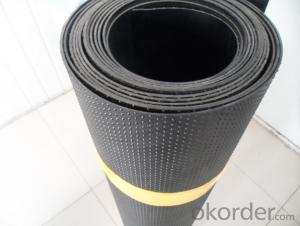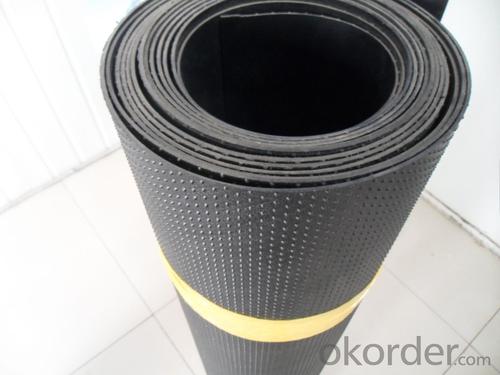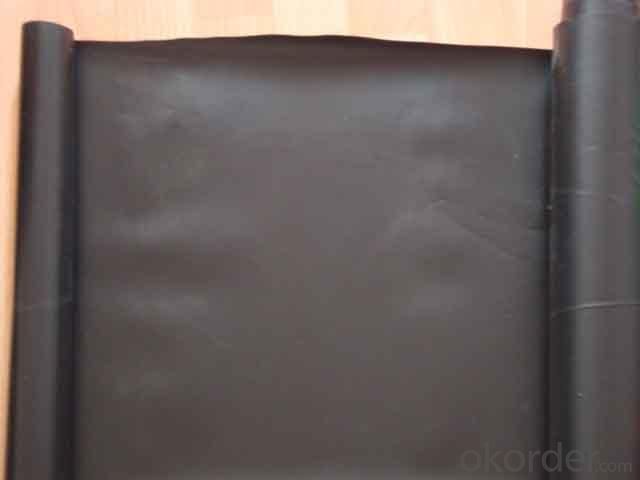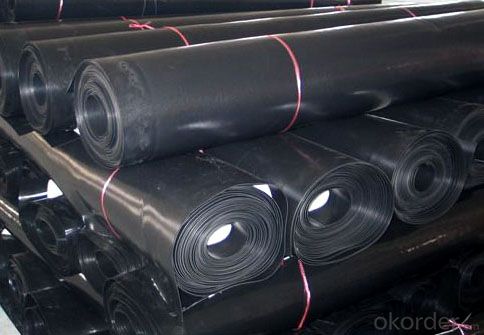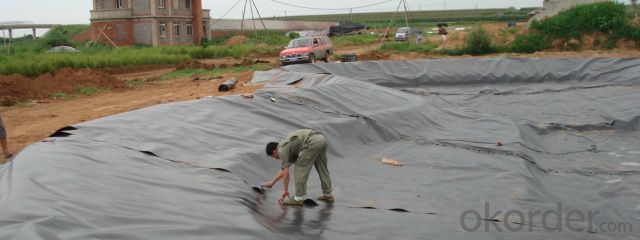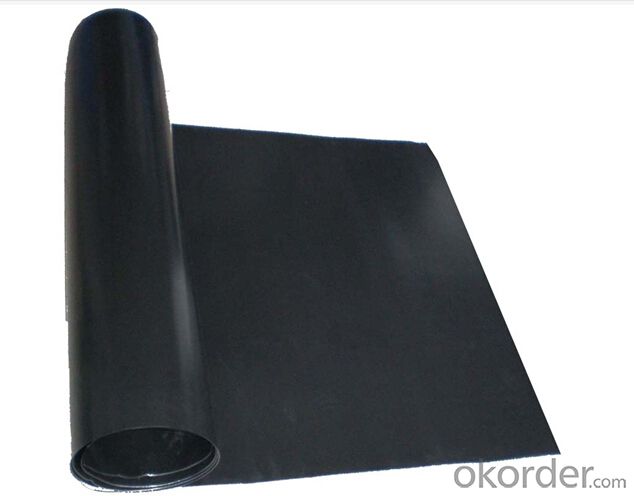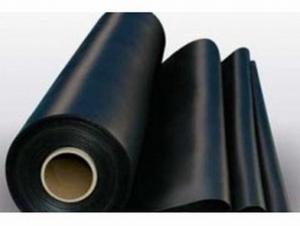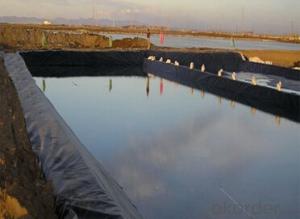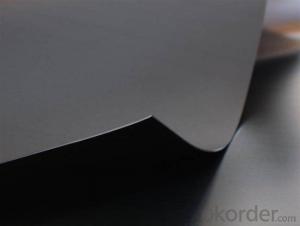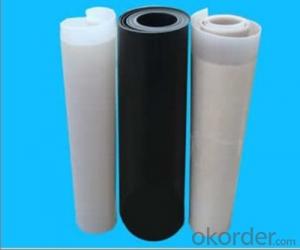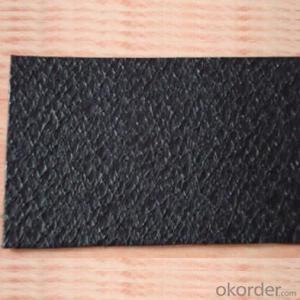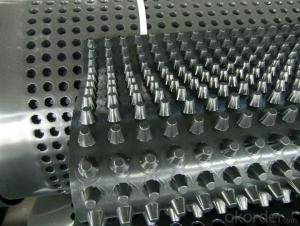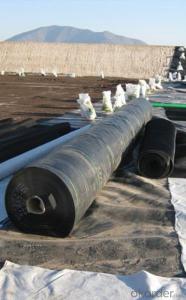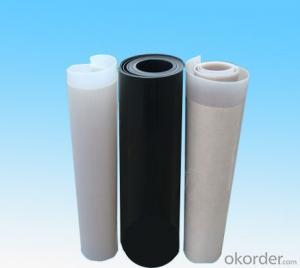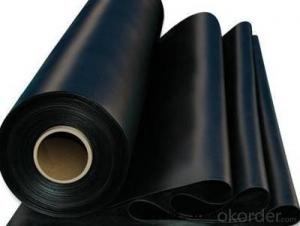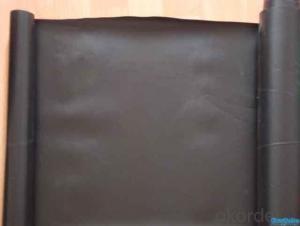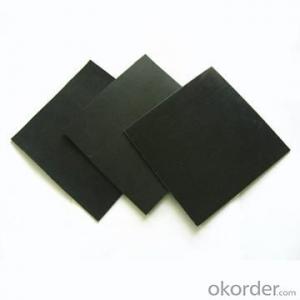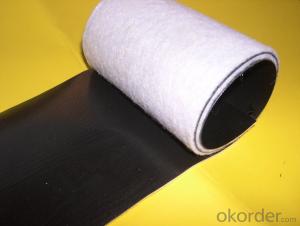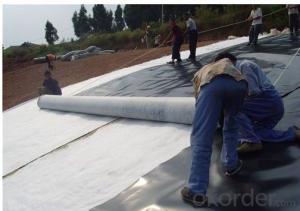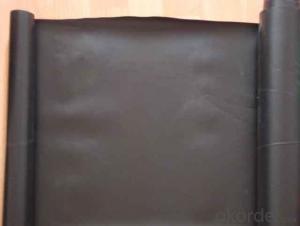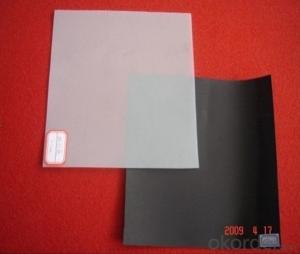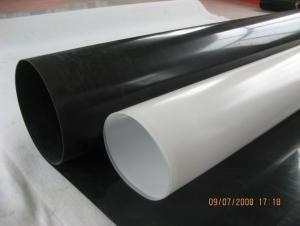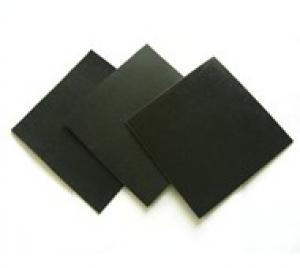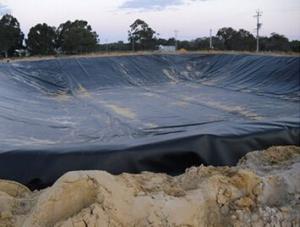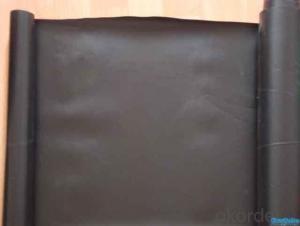Vi-20 LDPE Geomembrane for Pond Liner and Landfill
- Loading Port:
- Qingdao
- Payment Terms:
- TT or L/C
- Min Order Qty:
- 10000 m²
- Supply Capability:
- 300000 m²/month
OKorder Service Pledge
OKorder Financial Service
You Might Also Like
1. Specification and Technical Sheet of LDPE Geomembrane
Iterm | Technical Data | ||||||
Thickness mm | 0.75 | 1 | 1.25 | 1.5 | 2 | 2.5 | 3 |
Density g/cm3 | ≥0.940 | ≥0.940 | ≥0.940 | ≥0.940 | ≥0.940 | ≥0.940 | ≥0.940 |
Yield Strength N/mm | ≥11 | ≥15 | ≥18 | ≥22 | ≥29 | ≥37 | ≥44 |
Break Strength N/mm | ≥20 | ≥27 | ≥33 | ≥40 | ≥53 | ≥67 | ≥80 |
Yield Elongation % | ≥12 | ≥12 | ≥12 | ≥12 | ≥12 | ≥12 | ≥12 |
Break Elongation % | ≥700 | ≥700 | ≥700 | ≥700 | ≥700 | ≥700 | ≥700 |
Tear Resistance N | ≥93 | ≥125 | ≥160 | ≥190 | ≥250 | ≥315 | ≥375 |
Puncture Resistance N | ≥240 | ≥320 | ≥400 | ≥480 | ≥640 | ≥800 | ≥960 |
Carbon Black Content % | 2.0-3.0 | 2.0-3.0 | 2.0-3.0 | 2.0-3.0 | 2.0-3.0 | 2.0-3.0 | 2.0-3.0 |
Standard OIT min | ≥100 | ≥100 | ≥100 | ≥100 | ≥100 | ≥100 | ≥100 |
High Pressure OIT min | ≥400 | ≥400 | ≥400 | ≥400 | ≥400 | ≥400 | ≥400 |
Oven Aging at 85°C % | ≥55 | ≥55 | ≥55 | ≥55 | ≥55 | ≥55 | ≥55 |
UV Resistance % | ≥50 | ≥50 | ≥50 | ≥50 | ≥50 | ≥50 | ≥50 |
2. Introduction of HDPE Geomembrane
LDPE geomembrane is based on the material of plastic film, relative to the HDPE geomembrane has better applied and suppleness, is to update the generation of soil seepage control material. LDPE geomembrane and geotextile glue them into a soil anti-seepage material it has corrosion resistance, good low temperature resistance, light quality, laceration resistant ability and other characteristics; The characteristics of its low cost, high quality and low price is not matched by other same category geotechnical seepage control material.
3. Introduction of HDPE Geomembrane
1), Environmental protection, sanitation, such as landfill, sewage treatment plant, power plant regulation pool, industrial, hospitals, solid wastes, etc.;
2), Water conservancy projects, such as rivers and lakes of reservoir dam seepage and leakage, reinforcement, the canal seepage control, vertical wall, slope protection, etc.;
3), Municipal engineering: the subway, building underground engineering, planting roof, roof garden, sewage pipe seepage control;
4), Polyethylene anti-seepage film applicable garden: artificial lake, river, reservoir and golf course of the bottom of the pond, slope protection, green lawn waterproof, etc;
5), Petrochemical, chemical plants, refineries, storage tanks, seepage control, chemical reaction pool, sedimentation tank lining and secondary lining, etc.
6), Mining: washing pool, pool heap leaching, heap yard, dissolving tank, tank, the bottom line of the yard, tailings anti-seepage, etc;
7), Agriculture: reservoir, the drinking pool, XuShuiTang, waste treatment, seepage of irrigation system;
8), Aquaculture: intensive, factory breeding pool, fish pond, shrimp ponds circle of lining, sea cucumber, slope protection, etc.;
9),Salt industry: saltworks crystallization pool, halogen pool plastic film covering, salt film, salt pond Shan membrane.
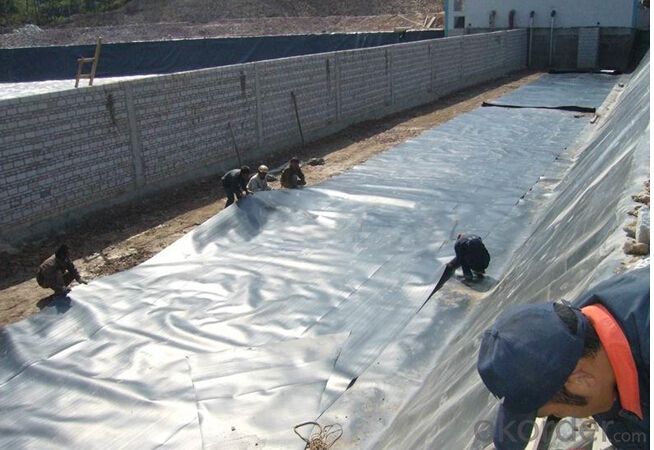
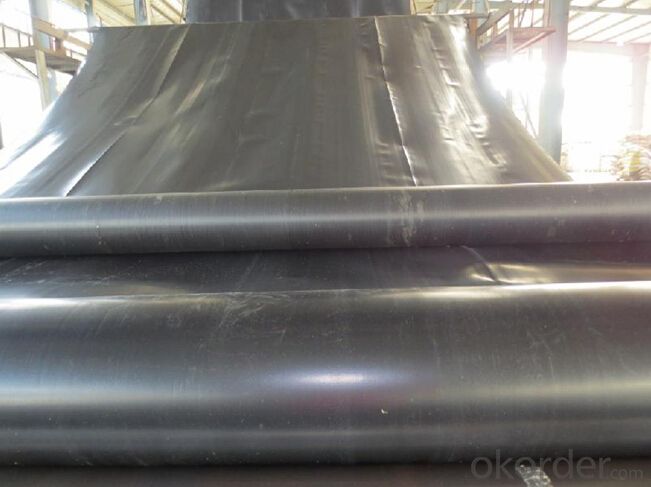
FAQ:
- Q: What can we do for the special customer?
A: Provide custom made service with customer's drawing; We make sure to provide you with the best solutions for your individual case. Whether standard items or non-standard items.
- Q: What can we supply?
A: We provide high levels of communication from start to finish.
- Q: What is our advantage?
A: Top Cemented Carbide has extensive business experience, Fast delivery and high quality.
- Q: What are the limitations of geomembranes in extreme temperature conditions?
- Geomembranes have limitations in extreme temperature conditions due to their thermal expansion and contraction properties. At extremely high temperatures, geomembranes can become brittle and prone to cracking or tearing. Conversely, at extremely low temperatures, they can become stiff and lose their flexibility, making them more susceptible to damage. Moreover, fluctuating temperature cycles can accelerate the aging process of geomembranes, reducing their overall lifespan. Therefore, careful considerations and additional measures such as insulation or appropriate material selection are necessary to mitigate these limitations in extreme temperature conditions.
- Q: Construction technology of geomembrane:
- Notes for geomembrane joints: (1) the joint treatment of the geomembrane is the key process of construction, which directly affects the service life of the project. Indicated by quality test, hot weiding is an ideal way. (special adhesive is also available). Heat welding method is heating the surface which is connected with the PE geomembrane, the surface melting, and then through the pressure to merge them into one, (2) Geomembrane shall be paved along a certain direction, on both sides of the geomembrane should be reserved for certain PE membrane and PET membrane bonding layer.While paving, we should adjust the tendency of geomembrane of each unit, in order to bring convenience to two units geomembrane welding. (3) Press geomembrane with sand bags to prevent wind after pavement, edge joints requires no dirt, moisture, dust, etc.. (4) before welding, adjust the joint at two sides of PE membrane, jointing them with broadband, and making them smooth, and no wrinkle. (5) When welding, it is better to have a technical personnel of certain experience, and use a special welding machine for welding. Adjust the temperature and speed, (can also use adhesive to bond). According to many years of practice, it is proved that the thickness of the geomembrane is not less than 0.25mm, because too thin is possible to produce porosity, and it is easy to be damaged in the construction to reduce the seepage control effect. During the construction of geomembrane, we should pay special attention that the pavement should not be too tight, shouldn't wrinkle, and the jointing should be firm. We should construct strictly according to the technical specifications, checking five quality clearance comprising preparation, paving, splicing joints, testing and backfill.
- Q: Can geomembranes be used for waterproofing?
- Yes, geomembranes can be used for waterproofing. They are thin, flexible sheets made from various materials such as synthetic polymers or rubber, and are designed to provide an impermeable barrier against water. Geomembranes are commonly used in construction projects, such as lining ponds, landfills, or tunnels, to prevent water leakage and protect the surrounding environment. They are also used for waterproofing structures like basements or roofs, ensuring that water does not penetrate through the building materials.
- Q: How do geomembranes help in groundwater protection?
- Geomembranes help in groundwater protection by acting as a barrier to prevent contaminants from infiltrating the groundwater. These synthetic liners are impermeable and can be used to line landfills, ponds, and other containment areas to prevent leakage of hazardous substances into the underlying groundwater. This helps in safeguarding the quality and availability of groundwater resources, which are crucial for drinking water supply and ecosystem health.
- Q: In which areas can electronic Whiteboard film be used?
- It can be used on computer and projector and is effectively scratch-proof.
- Q: Can geomembranes be used in canal lining applications?
- Yes, geomembranes can be used in canal lining applications. They are often used as a cost-effective and efficient method to prevent seepage and leakage in canals, providing a durable and impermeable lining that helps to conserve water resources and maintain the integrity of the canal system.
- Q: What is the role of geomembranes in coal seam gas extraction?
- Geomembranes play a crucial role in coal seam gas extraction by acting as a barrier to prevent the migration of gas and other contaminants from the coal seam to the surrounding environment. They are used to line and seal the wellbore and storage ponds, ensuring the containment and safe disposal of wastewater and produced fluids. Additionally, geomembranes help in managing and controlling the water flow within the coal seam, optimizing gas production and minimizing potential environmental impacts.
- Q: Can geomembranes be repaired?
- Yes, geomembranes can be repaired. Various repair methods such as patching, welding, or sealing can be used to fix damages or leaks in geomembranes. The specific repair technique depends on the type of geomembrane material and the extent of the damage.
- Q: What is the welding method of geotextile?
- It is easy to weld the geotextiles that manual rolling and paving is enough. The surface should be flat with some deformation allowance left. The long or short nonwoven geotextiles are often bonded by lapping, seaming and welding. The seamed and welded overlap is generally more than 0.1m wide. The lapped overlap is generally more than 0.2m wide. For geotextiles with long exposure time, methods of welding and seaming are recommended. Continue seaming until the all the work is completed. (disconnected seaming is not allowed.) Before being bonded, the overlaps should not be less than 150mm wide. The minimum distance of seams to the edges (the exposed edge of material) is 25mm. The thread for seaming should be made from resin with tensile strength no less than 60N, with chemical resistance and UV resistance that are the same with that of geotextile or exceed that of geotextile. Any "missed stitch" should be avoid. Actions should be taken accordingly to prevent emission of soil, particulate matters or foreign matters.
- Q: What are the long-term performance characteristics of geomembranes?
- The long-term performance characteristics of geomembranes include their ability to withstand environmental stressors such as UV radiation, temperature fluctuations, chemical exposure, and mechanical stress without significant degradation. They are also expected to maintain their impermeability, strength, and flexibility over time to ensure the integrity of containment and barrier systems. Regular inspections and maintenance can help prolong their lifespan and ensure their long-term performance.
1. Manufacturer Overview
| Location | Taian City,Shandong Province,China |
| Year Established | 2003 |
| Annual Output Value | Above US$100 Million |
| Main Markets | Africa, North America, Eastern Europe, South Asia, Western Europe |
| Company Certifications | ISO9001;IS014001 Certificate |
2. Manufacturer Certificates
| a) Certification Name | |
| Range | |
| Reference | |
| Validity Period |
3. Manufacturer Capability
| a) Trade Capacity | |
| Nearest Port | Qingdao Port;Tianjing Port;Shanghai Port |
| Export Percentage | |
| No.of Employees in Trade Department | 21-30 People |
| Language Spoken: | English; Chinese; |
| b) Factory Information | |
| Factory Size: | 10,000-30,000 square meters |
| No. of Production Lines | Above 10 |
| Contract Manufacturing | Geotechnical Material (Geogrid,Fiberglass/Polyester Geogrid;Geocell;Geonet and Geomat;Plastic Safety Fence);Plastics products;Rubber products;Geotextile;Carpet;Compound geomembrane |
| Product Price Range | Average |
Send your message to us
Vi-20 LDPE Geomembrane for Pond Liner and Landfill
- Loading Port:
- Qingdao
- Payment Terms:
- TT or L/C
- Min Order Qty:
- 10000 m²
- Supply Capability:
- 300000 m²/month
OKorder Service Pledge
OKorder Financial Service
Similar products
Hot products
Hot Searches
Related keywords
